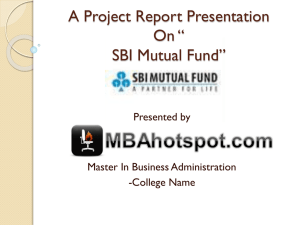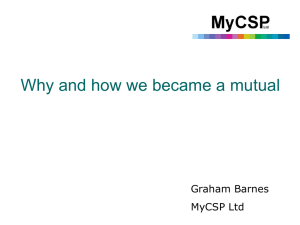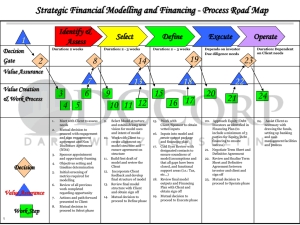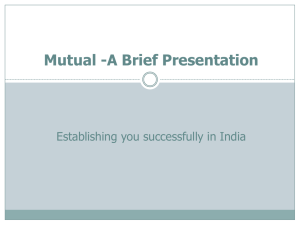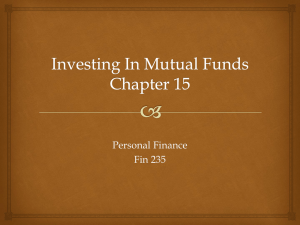Mutual Funds
advertisement
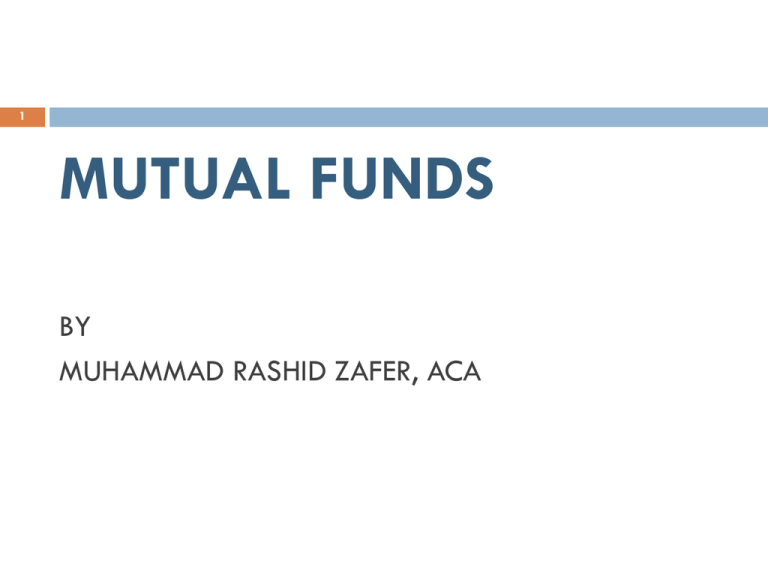
1 MUTUAL FUNDS BY MUHAMMAD RASHID ZAFER, ACA WHAT IS MUTUAL FUND 2 An investment vehicle that pools money from many investors and invest it according to predetermined objective. Each investor gets a share of the pool proportionate to the initial investment. Capital of the mutual fund is divided into shares or units. Mutual funds invest in bonds, stocks, money-market instruments, real estate, commodities or a combination of any of these. FLOW OF FUNDS 3 HISTORY OF MUTUAL FUNDS 4 The first mutual fund was established in Europe. A Dutch merchant Adriaan van Ketwich created the first mutual fund in 1774. “Eendragt Maakt Magt”, which meant “Unity Creates Strength”. First mutual fund outside the Netherlands was the Foreign & Colonial Government Trust, which was established in London in 1868. Mutual funds were introduced into the United States in the 1890s. They became popular during the 1920s. HISTORY OF MUTUAL FUNDS 5 In 1893, the first closed-end fund “The Boston Personal Property Trust” was formed. In year 1924, the first open-end fund “Massachusetts Investors’ Trust of Boston” was the formed. In Pakistan NIT offered first open end fund in 1962. ICP offered a series of closed end funds in 1966, these were later privatized in 2000. PROS AND CONS OF MUTUAL FUNDS 6 Diversification. Securities from hundreds or even thousands of issuers it reduces the risk of loss. Professional Management. Expertise to manage and reinvest interest or dividend income, or to investigate thousands of securities. Access to extensive research, market information, and skilled securities traders. Liquidity. Mutual fund can be bought and sold on any business day, so investors have easy access to their money. Many individual securities can also be bought and sold readily, others aren't widely traded. (CE & IC) PROS AND CONS OF MUTUAL FUNDS 7 Convenience. Mutual funds offer services that make investing easier. Mail, telephone, or the Internet. Automatic investments into a fund or automatic transfers from a fund to your bank account. Tax Free Return The stock dividend from mutual funds are exempt from tax. Cash dividend taxable. PROS AND CONS OF MUTUAL FUNDS 8 No Guarantees. Unlike bank deposits, principal and returns are not guaranteed. Diversification “Penalty." Diversification reduces the risk of loss, it also limits the potential for making a killing in the market. Diversification does not protect from a loss caused by an overall decline in financial markets. MUTUAL FUNDS - STRUCTURES 9 Open End – continuously offer and redeem their units to the investors. Closed End – one time issuance of certificates and then are traded in the secondary market. Investment Company – one time issuance of shares and then are traded in the secondary market. LEGAL STRUCTURE 10 Open end and closed end funds are established through a trust deed as a trust under the trust act 1888. Investment Company is established as a limited liability company. Operated by two parties i.e. fund manager and the trustee or custodian. CDC - largest trustee of mutual funds in Pakistan with almost 90% of the market share. SECP through NBFC Regulations 2008 regulates the mutual fund industry. TERMINOLOGIES & DOCUMENTS 11 Net Asset Value Trust Deed Offering Documents Sales Load PARTIES TO MUTUAL FUND 12 Fund Manager Manage the assets of the mutual fund. Maintenance of financial and other records and documents. Maintenance of the record of unit or certificate holders. Receipt and processing of investment and redemption applications. PARTIES TO MUTUAL FUND 13 Trustee Hold all the property mutual fund for the unit or certificate holder. Settlement of transaction entered into by the fund manager. Ensure the methodology and procedures adopted by the fund manager in calculating the value of units are adequate. Monitoring of the actions of fund manager in the light of applicable law i.e. to act as front line regulator. MUTUAL FUNDS - TYPES 14 Money Market Fund – invest mainly in money market instruments i.e. fixed income securities with short maturity and high credit quality. Bond Fund – invest mainly in bonds having longer maturity. Equity Funds – invest primarily in stocks. Hybrid Funds – invest in both bonds and stocks. Index Fund or Index Tracker – aims to replicate the movements of an index regardless of market conditions. MUTUAL FUNDS – TYPES - PAKISTAN 15 Equity Fund At least 70% of the net assets invested in listed equity securities. Remaining net assets invested in cash or near cash instruments, treasury bills. No exposure in CFS. MUTUAL FUNDS – TYPES - PAKISTAN 16 Balanced Fund 30% to 70 % invested in listed equity securities. Remaining assets in money market instruments, commercial paper, reverse repo, TFCs, sukuks, CFS, spread, preference shares. Rating of debt security not lower than A-. Rating of bank not lower than AA-. Weighted average time to maturity of non equity assets should not exceed 2 years. Investment in CFS and spread should not exceed 25%. MUTUAL FUNDS – TYPES - PAKISTAN 17 Asset Allocation Fund May invest in any type of security at any time and may diversify as per the offering document. The offering document must specify the types of securities and the rating criteria. MUTUAL FUNDS – TYPES - PAKISTAN 18 Fund of Funds Invest its assets in other funds only. Remaining in bank accounts and treasury bills not exceeding 90 days. Must not invest in seed capital. May be equity, income, money market etc. MUTUAL FUNDS – TYPES - PAKISTAN 19 Capital Protected / Guaranteed Fund Make investments in such manner that the original capital is protected while yielding positive returns. Normally capital protection is achieved by placing the capital in term deposits with bank. Rating of the bank should not be lower than AA-. MUTUAL FUNDS – TYPES - PAKISTAN 20 Index Fund Strive to remain fully invested in accordance with the stated index. Under no circumstances investment fall below 85% of the assets in securities covered in the index. Any remaining asset must be kept in bank account or treasury bills not exceeding 90 days. Efficient Market Hypothesis MUTUAL FUNDS – TYPES - PAKISTAN 21 Money Market Fund Invest in cash and near cash instruments i.e. treasury bills, money market instruments, commercial papers, reverse repo etc. No exposure in equities, CFS, spread transaction. Rating of any security should not be lower than AA. Maturity time of any asset should not exceed six months. Weighted average time to maturity should not exceed 90 days. MUTUAL FUNDS – TYPES - PAKISTAN 22 Income Fund Invest in government securities, TDRs, commercial papers, reverse repo, TFCs/sukuks, CFS, spread transactions. Rating of any security should not be lower than investment grade. No restriction regarding time to maturity of any single assets in the portfolio. Weighted average time to maturity of assets shall not exceed 4 years. MUTUAL FUNDS – TYPES - PAKISTAN 23 Aggressive Fixed Income Fund Invest in government securities, TDRs, cmmercial papers, reverse repo, TFCs/sukuks, CFS, spread transaction. Both rated and unrated security are eligible for investment. No restriction regarding time to maturity of any single assets in the portfolio. Weighted average time to maturity of assets shall not exceed 5 years. MUTUAL FUNDS – TYPES - PAKISTAN 24 Islamic Funds May be categorized as income, money market, fund of funds, equity, balanced or index tracker. All the investments must be Shariah compliant. Investment avenues includes Shariah compliant stocks, sukuks, deposit with Islamic banks, spread transactions etc. SCREENING CRITERAIA FOR ISLAMIC EQUITY FUNDS 25 Criteria – 1 Business of the Investee Company The business of the investee company should be Halal. Criteria – 2 Illiquid Assets Must be 20% of the Total Assets Illiquid assets means plant and machinery, inventory etc. Criteria – 3 Market Price Per Share > Net Liquid Assets Per Share Net Liquid Assets = TA-ILA-TL SCREENING CRITERAIA FOR ISLAMIC FUNDS 26 Criteria – 4 Non-Compliant Income < 5% of Gross Revenue Non Compliant Income includes interest, income from gambling, gains on derivatives. Criteria – 5 Non-Shariah Compliant Investments < 33% of Total Assets Non-Shariah Compliant Investments include investments in money market funds, money market instruments, bonds, PIBs, CoIs, CoDs, TFCs, DSCs, derivatives etc. SCREENING CRITERAIA FOR ISLAMIC FUNDS 27 Criteria – 6 Interest Bearing Debt < 40% of Total Assets Interest bearing debt includes bonds, TFCs, conventional bank loans, finance lease, and preference shares etc. DEBT VERSUS EQUITY FINANCING 28 Debt financing is a double edged sword. Leveraged companies can magnify their returns in booms, but in slumps, they lose the edge and can even go bankrupt. Debt financing results in a zero-sum game in which at least one stakeholder i.e. shareholders or creditors suffer. Equity financing ensures normal returns in booms and survival in slumps. Therefore, the company will not be squeezed of liquidity as interest expense as an ‘autonomous expense’ will not feature as a significant portion of total operating expenses. A SIMPLIFIED ECONOMIC MODEL 29 Non Leverage Company Assets Rs. Equity + Liability Rs. Fixed Assets 60 Debt 0 Current Assets 40 Equity 100 100 Total 100 Total A SIMPLIFIED ECONOMIC MODEL 30 Economic Boom Income Statement Non Leveraged Company Net Sales Economic Recession Income Statement Rs. Non Leveraged Company 100 Net Sales Rs. 60 Cost of Goods Sold 70 Cost of Goods Sold (70%) 42 Gross Profit 30 Gross Profit 18 Operating Expenses 10 Operating Expenses 10 PBIT 20 PBIT Interest Expense PBT Tax Expense (20%) Net Income ROE 0 Interest Expense 20 PBT 4 Tax Expense 16 Net Income 16% ROE 8 0 8 1.6 6.4 6.4% A SIMPLIFIED ECONOMIC MODEL 31 Leveraged Company Assets Rs. Equity + Liability Rs. Fixed Assets 60 Debt 60 Current Assets 40 Equity 40 Total 100 Total 100 A SIMPLIFIED ECONOMIC MODEL 32 Economic Boom Income Statement Leveraged Company Net Sales Economic Recession Income Statement Rs. Leveraged Company 100 Net Sales Rs. 60 Cost of Goods Sold 70 Cost of Goods Sold 42 Gross Profit 30 Gross Profit 18 Operating Expenses 10 Operating Expenses 10 PBIT 20 PBIT Interest Expense (12%) 7.2 Interest Expense PBT 12.8 PBT Tax Expense (20%) 2.56 Tax Expense Net Income ROE 10.24 Net Income 25.6% ROE 8 7.2 0.8 0.16 0.64 1.6% TAX STRUCTURE 33 Income Tax Ordinance, 2001 Income of mutual fund is exempt subject to distribution of ninety percent of accounting income reduced by capital gains realized or unrealized. Mutual funds are also exempt from withholding tax and capital gains tax. Investor will be taxed on cash dividend @ 10% stock dividend exempt. Investors have to pay capital gains tax if units, certificates or shares are redeemed/sold before one year. Investors also get rebate on income tax on their investment in mutual funds. 34 THANK YOU! rashidzafer@yahoo.com


